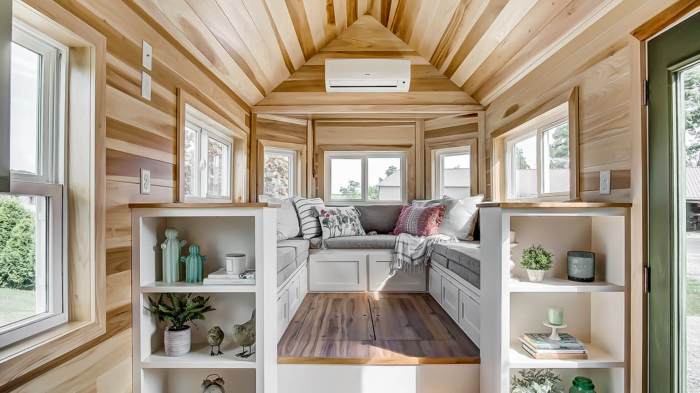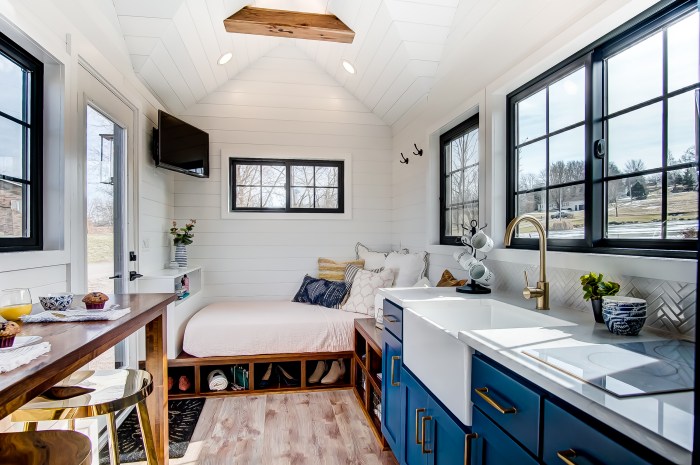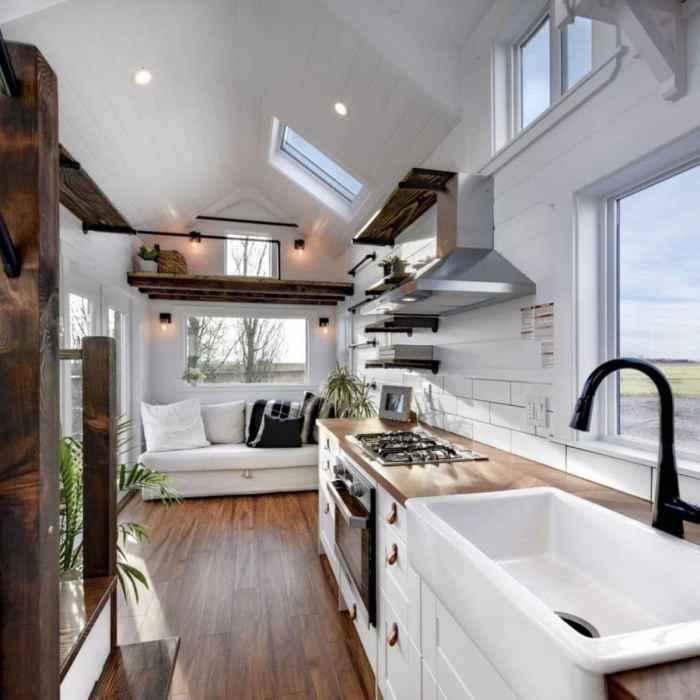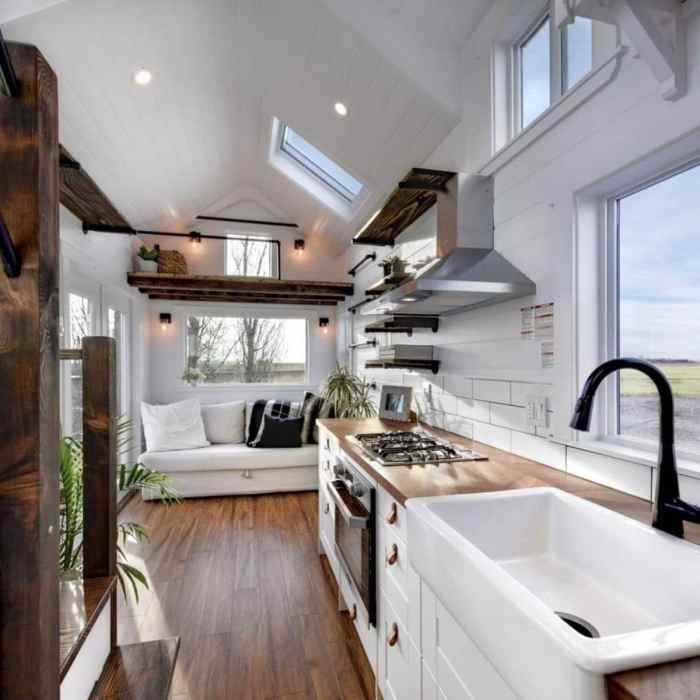Beautiful interior design for small houses is a challenge that can be overcome with creativity and planning. Transforming a compact space into a stylish and functional haven is a rewarding endeavor, demanding a keen eye for detail and an understanding of space optimization techniques.
By embracing smart design strategies, you can create a home that is both visually appealing and comfortable, despite its limited square footage.
This guide explores the key principles of small space design, including maximizing natural light, choosing furniture wisely, and implementing clever storage solutions. We’ll delve into popular interior design styles suitable for small homes, such as minimalist, Scandinavian, and farmhouse, and discuss how to create a cohesive color palette and incorporate patterns and textures to add visual interest without overwhelming the space.
Understanding Small Space Design Principles
Living in a small house can be a challenge, but it can also be an opportunity to create a stylish and functional space. By understanding the key principles of small space design, you can transform your compact home into a haven of comfort and beauty.
Maximizing Space
Effective space maximization is paramount in small house design. It involves utilizing every inch wisely, optimizing functionality, and creating a sense of spaciousness. Here are some key principles:
- Multi-Functional Furniture:Employing furniture that serves multiple purposes is crucial. For instance, a sofa bed can transform into a sleeping area, while a coffee table with storage can double as a place to keep essentials.
- Vertical Space:Utilize vertical space effectively by incorporating shelves, wall-mounted storage, and hanging organizers.
This helps keep belongings off the floor and creates a sense of openness.
- Minimalism:Embrace a minimalist approach by decluttering and only keeping items that are essential. This not only frees up space but also creates a sense of calm and order.
The Role of Light and Color
Light and color play a vital role in creating an illusion of spaciousness. By strategically using light and color, you can make a small space feel larger and more inviting.
- Natural Light:Maximize natural light by using sheer curtains, light-colored walls, and strategically placing mirrors to reflect light.
- Light Colors:Opt for light colors for walls, furniture, and décor. Light colors reflect light, making a space feel larger and airier.
- Strategic Use of Color:Use pops of color strategically to create visual interest and define different areas.
For example, a bold accent wall can draw attention to a specific area.
Clever Storage Solutions, Beautiful interior design for small house
Storage solutions are crucial in small spaces. They help keep belongings organized and out of sight, maximizing available space.
- Built-in Storage:Incorporate built-in storage solutions, such as shelves, drawers, and cabinets, to maximize vertical space.
- Hidden Storage:Utilize hidden storage spaces, such as under-bed storage, storage ottomans, and wall-mounted storage solutions.
- Open Shelving:Open shelving can create a visually appealing display while also providing storage space.
Creating a Cohesive Interior Design Style: Beautiful Interior Design For Small House
A cohesive interior design style is crucial for small homes, as it helps to create a sense of harmony and spaciousness. By choosing a specific style and adhering to its principles, you can unify the design elements and create a visually appealing and functional space.
A beautiful interior design for a small house is all about maximizing space and creating a sense of openness. Clever storage solutions, multi-functional furniture, and a light and airy color palette are key. If you’re working with a particularly compact space, take inspiration from the 250 sq ft house interior design trend, which emphasizes minimalist design and smart space utilization.
Remember, even in a small house, you can create a stunning and functional living environment.
Choosing a Suitable Interior Design Style
Choosing a suitable interior design style is the first step towards creating a cohesive look for your small house. Certain styles are particularly well-suited for smaller spaces due to their emphasis on simplicity, functionality, and light. Some popular styles for small homes include:
- Minimalist: Minimalist design focuses on simplicity, clean lines, and a limited color palette. This style emphasizes functionality and avoids clutter, making it ideal for small spaces.
- Scandinavian: Scandinavian design incorporates natural materials, light colors, and simple furniture. Its emphasis on functionality and light creates a spacious and airy feel, perfect for small homes.
- Farmhouse: Farmhouse style embraces rustic charm and natural elements. It features warm colors, natural textures, and vintage furniture, creating a cozy and inviting atmosphere in small spaces.
- Contemporary: Contemporary design emphasizes clean lines, geometric shapes, and neutral colors. Its modern aesthetic can make a small space feel sophisticated and spacious.
Designing a Cohesive Color Palette
A well-chosen color palette is essential for creating a cohesive and visually appealing interior design. For small spaces, it’s recommended to use a limited color palette with a primary color, an accent color, and neutral tones.
- Primary Color: This is the dominant color in the space and sets the overall tone. It should be chosen based on the desired ambiance and the chosen design style.
- Accent Color: This color adds pops of vibrancy and interest to the space. It can be used for furniture, accessories, or artwork.
- Neutral Tones: Neutral colors, such as white, gray, beige, and black, provide a backdrop for the primary and accent colors. They help to create a sense of spaciousness and balance.
For example, a minimalist living room could use white as the primary color, a light blue as the accent color, and gray as the neutral tone. This combination creates a calming and airy ambiance.
Using Patterns and Textures
Patterns and textures can add visual interest and depth to a small space without overwhelming it. It’s important to use them strategically to enhance the overall design.
Creating a beautiful interior design for a small house can be a fun challenge. One great way to maximize space and bring in a sense of calm is to embrace a coastal aesthetic, drawing inspiration from beach house interior design ideas.
Think light and airy colors, natural textures, and accents of blue and green to create a tranquil and inviting atmosphere, even in a smaller space.
- Patterns: Patterns can be incorporated through furniture upholstery, rugs, curtains, or artwork. Choose patterns that complement the chosen design style and color palette. For small spaces, it’s best to use small-scale patterns or geometric patterns that create a sense of order and balance.
- Textures: Textures can be added through materials like wood, linen, wool, or leather. Different textures create visual interest and tactile experiences. For example, a fluffy rug can add warmth and comfort to a minimalist living room, while a textured throw blanket can add a touch of elegance to a Scandinavian bedroom.
Remember to use patterns and textures in moderation, as too much can make a small space feel cluttered. It’s best to stick to one or two patterns and a few different textures to create a balanced and cohesive look.
Maximizing Natural Light

Maximizing natural light in a small house is crucial for creating a sense of spaciousness and enhancing the overall ambiance. By strategically incorporating windows and utilizing light-reflecting elements, you can transform your home into a bright and welcoming space.
Choosing Window Treatments
Window treatments play a vital role in controlling the amount of natural light entering your home. The right choices can amplify light flow while maintaining privacy and style.
- Sheer Curtains:These delicate fabrics allow ample light to filter through while still providing a degree of privacy. They are ideal for rooms where you want to maintain a bright and airy atmosphere.
- Roller Blinds:These blinds are simple and effective for controlling light levels. They can be easily raised or lowered to adjust the amount of light entering the room. For a brighter effect, choose light-colored blinds.
- Skylights:Installing skylights is a great way to introduce natural light into areas that might otherwise be dark. They can significantly brighten up a room and create a sense of openness.
Utilizing Mirrors to Reflect Light
Mirrors are powerful tools for amplifying natural light in a small space. By strategically placing mirrors, you can create the illusion of a larger and brighter room.
Placing a mirror opposite a window will reflect natural light back into the room, doubling the amount of light.
Imagine a small living room with a large window facing south. To maximize the light, you could place a large mirror on the wall opposite the window. The mirror will reflect the sunlight back into the room, creating a brighter and more spacious feel.
Additionally, placing smaller mirrors on other walls can further enhance the effect.
Furniture Selection and Placement
In a small house, furniture selection and placement are crucial for maximizing space and creating a functional and aesthetically pleasing environment. The right furniture pieces can transform a cramped space into a comfortable and inviting home.
Selecting Functional and Aesthetically Pleasing Furniture
When choosing furniture for a small house, it’s essential to consider both functionality and aesthetics. Here are some tips:
- Prioritize multi-functional pieces: Look for furniture that serves multiple purposes, such as a sofa bed that doubles as a guest bed or a coffee table with storage space. This will help to reduce clutter and maximize the use of available space.
- Choose furniture with a smaller footprint: Opt for compact furniture pieces that fit comfortably within the room without overwhelming the space. This might involve choosing a smaller sofa or a dining table that can be extended when needed.
- Consider the scale of the furniture: Ensure that the furniture pieces are proportionate to the size of the room. Oversized furniture can make a small space feel even smaller, while furniture that is too small can look lost.
- Think vertically: Utilize vertical space by incorporating tall bookshelves, wall-mounted mirrors, or floating shelves. This can help to create a sense of spaciousness while keeping the floor clear.
- Embrace lighter colors: Light colors can help to make a small space feel larger and brighter. Consider using light-colored furniture and walls to create a sense of openness.
Multi-functional Furniture Examples
Multi-functional furniture is a game-changer for small spaces. Here are some examples:
- Sofa beds: These offer a comfortable seating area during the day and transform into a bed for guests at night. They are ideal for living rooms that double as guest rooms.
- Storage ottomans: These provide extra seating and offer storage space for blankets, pillows, or other items. They are versatile and can be used in living rooms, bedrooms, or even hallways.
- Murphy beds: These fold away into a wall cabinet, maximizing space during the day. They are perfect for small bedrooms or guest rooms.
- Coffee tables with storage: These offer a surface for drinks and snacks while also providing storage for books, magazines, or remote controls.
- Shelving units: These can be used for books, décor, or even as a makeshift room divider. They are versatile and can be customized to fit your needs.
Bedroom Floor Plan
Here’s a basic floor plan for a small bedroom, demonstrating optimal furniture placement for maximizing space:
Imagine a rectangular bedroom. The bed is placed against the longest wall, leaving enough space to walk around it. A small nightstand is positioned on each side of the bed. A chest of drawers is placed against the opposite wall, providing storage space and acting as a room divider. A desk or vanity is placed in a corner, offering a dedicated workspace or makeup area. A small rug is used to define the seating area and add visual interest.
Storage Solutions for Small Spaces
In small homes, every inch counts. Clever storage solutions are essential for maintaining a clutter-free and organized living environment. By maximizing vertical space and incorporating multi-functional furniture, you can create a home that feels spacious and inviting, even in limited square footage.
Creating a beautiful interior design for a small house can be a challenge, but it’s definitely achievable! You can make the most of every inch of space by incorporating smart storage solutions, maximizing natural light, and choosing a color palette that creates a sense of spaciousness.
For inspiration, you might consider looking at 20×30 house interior design ideas, as they often feature clever space-saving techniques that can be adapted to smaller homes. Ultimately, the key to beautiful interior design in a small house is to prioritize functionality and create a space that feels both inviting and comfortable.
Creative Storage Solutions for Different Areas
Effective storage solutions are tailored to the specific needs of each room. Let’s explore some creative ideas for kitchens, bathrooms, and bedrooms.
Kitchens
- Under-Cabinet Storage:Maximize vertical space by installing pull-out shelves, baskets, or drawer organizers beneath cabinets. This creates extra storage for frequently used items, like spices, cookware, and utensils.
- Wall-Mounted Storage:Utilize vertical space with wall-mounted shelves, magnetic strips for knives and utensils, or pegboards for hanging pots and pans.
- Multi-Functional Furniture:Consider a kitchen island with built-in storage, or a rolling cart that can serve as a mobile work surface and storage unit.
Bathrooms
- Over-the-Toilet Storage:Install shelves or a cabinet above the toilet to store toiletries, towels, or extra linens.
- Vanity Storage:Opt for a vanity with multiple drawers, shelves, or pull-out baskets to organize toiletries, cosmetics, and other bathroom essentials.
- Wall-Mounted Storage:Install a medicine cabinet, towel racks, or shelves to maximize vertical space and keep items off the floor.
Bedrooms
- Under-Bed Storage:Utilize the space under the bed with storage bins, drawers, or a platform bed with built-in storage compartments.
- Wall-Mounted Storage:Install shelves, floating nightstands, or a headboard with built-in storage to keep items off the floor and within easy reach.
- Multi-Functional Furniture:Choose a bed frame with drawers, an ottoman with storage, or a wardrobe with built-in shelving and hanging space.
Vertical Storage and Wall-Mounted Shelves
Vertical storage and wall-mounted shelves are essential for maximizing space in small homes. They allow you to utilize the often-neglected vertical space, creating a sense of openness and minimizing clutter.
- Vertical Storage:This refers to using storage solutions that extend upwards, such as tall bookcases, cabinets, or shelves. By stacking items vertically, you can create more storage space without taking up valuable floor area.
- Wall-Mounted Shelves:Wall-mounted shelves are a versatile storage solution that can be used in various rooms. They are ideal for displaying decorative items, storing books, or organizing small items.
Storage Solutions for Different Areas of a Small House
| Area | Storage Solutions |
|---|---|
| Kitchen | Under-cabinet storage, wall-mounted shelves, multi-functional furniture, pantry organizers, drawer dividers. |
| Bathroom | Over-the-toilet storage, vanity storage, wall-mounted shelves, shower caddies, medicine cabinets. |
| Bedroom | Under-bed storage, wall-mounted shelves, closet organizers, storage ottomans, headboard storage. |
| Living Room | Coffee table with storage, entertainment center with storage, wall-mounted shelves, floating shelves, storage baskets. |
| Entryway | Coat rack, shoe storage, wall-mounted shelves, entryway bench with storage. |
Creating a Sense of Flow and Harmony

In a small house, where every square foot counts, it’s crucial to create a sense of flow and harmony between different spaces. This not only makes the home feel larger and more inviting but also ensures a seamless and enjoyable experience for everyone.
Creating Visual Continuity
A consistent design theme throughout the house is essential for creating a sense of flow. This means using a cohesive color palette, similar materials, and recurring design elements across different rooms. For instance, if you’re using warm wood tones in the living room, consider incorporating them into the bedroom or kitchen as well.
This consistency creates a sense of unity and makes the home feel more cohesive.
Budget-Friendly Design Tips
Designing a beautiful interior for a small house doesn’t have to break the bank. With a little creativity and planning, you can achieve a stylish and functional space without sacrificing your budget. This section will explore practical tips and affordable options to help you create a stunning small home that reflects your personal style.
Affordable Materials and DIY Projects
Utilizing affordable materials and embracing DIY projects can significantly reduce your design costs. By exploring budget-friendly options and putting your skills to work, you can create unique and personalized elements for your small space.
- Secondhand Furniture:Thrift stores, antique shops, and online marketplaces offer a treasure trove of affordable furniture pieces. With a little sanding, painting, or reupholstering, you can transform these finds into statement pieces that add character to your home.
- Upcycled Materials:Repurposing old items into decorative elements is a great way to add personality and save money. Old crates can be turned into shelves, vintage suitcases can be transformed into coffee tables, and reclaimed wood can be used for wall art or accent pieces.
- DIY Projects:Engaging in DIY projects allows you to personalize your home with unique and affordable creations. You can paint walls, build shelves, create artwork, or even design your own throw pillows.
Prioritizing Quality Over Quantity
When decorating a small home, it’s crucial to prioritize quality over quantity. Investing in a few well-chosen pieces can have a greater impact than buying numerous cheap items that may quickly become outdated.
“A few well-chosen pieces can have a greater impact than buying numerous cheap items.”
- Durable Furniture:Investing in sturdy and timeless furniture pieces that are built to last will save you money in the long run. Choose furniture made from high-quality materials like solid wood or metal, which will withstand wear and tear and remain stylish for years to come.
- Statement Pieces:Rather than filling your small space with numerous items, focus on incorporating a few statement pieces that make a strong visual impact. This could be a unique rug, a bold piece of art, or a well-designed lighting fixture.
- Versatile Decor:Opt for versatile decorative elements that can be easily rearranged and repurposed. For example, a large throw blanket can be used as a sofa cover, a bedspread, or even a wall tapestry.
Final Wrap-Up

Designing a beautiful interior for a small house is an exciting challenge that allows you to embrace creativity and resourcefulness. By applying the principles of maximizing space, embracing a cohesive design style, and incorporating personal touches, you can transform a small home into a haven of style and functionality.
Remember, every inch counts, and every detail contributes to the overall aesthetic. With careful planning and a touch of imagination, you can create a small house that feels spacious, inviting, and uniquely yours.
Query Resolution
What are some common mistakes to avoid when designing a small house?
Overcrowding the space with too much furniture, using dark colors that make the space feel smaller, neglecting natural light, and failing to plan for adequate storage are common mistakes to avoid.
How can I make a small bedroom feel more spacious?
Use light colors, choose a bed frame with storage, utilize vertical space with shelves or wall-mounted organizers, and keep clutter to a minimum.
What are some budget-friendly ways to enhance the interior design of a small house?
DIY projects, thrifting furniture, using affordable materials like paint and fabric, and incorporating natural elements like plants can all enhance the design of a small house on a budget.
